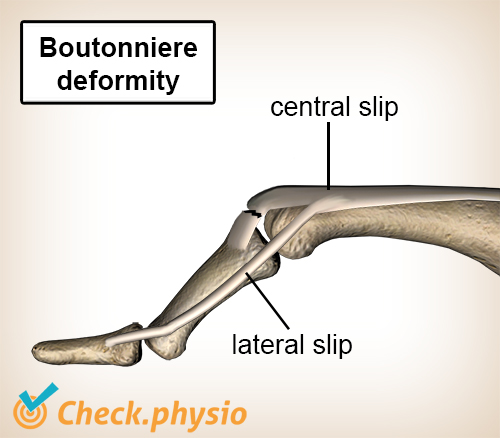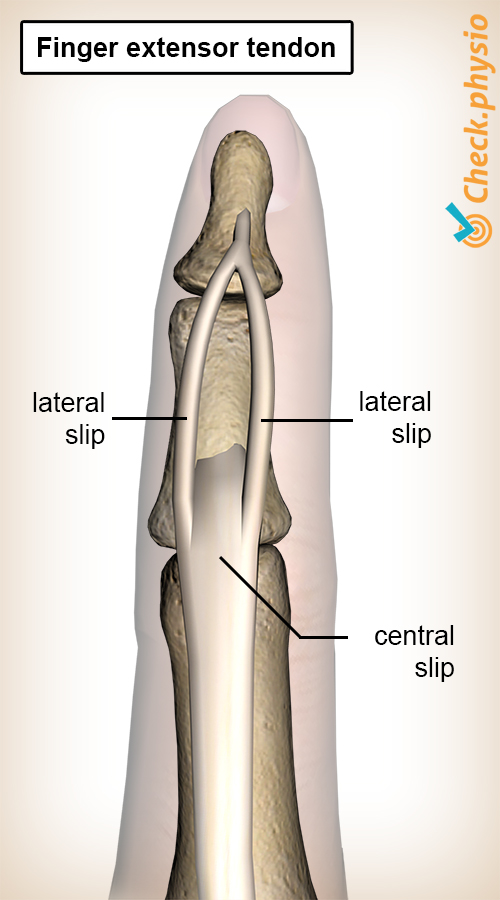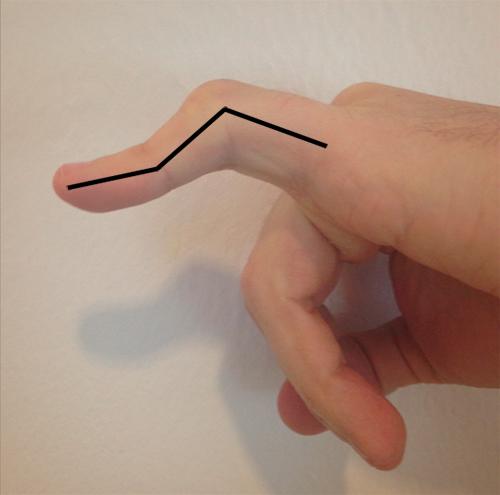- Conditions
- Boutonnière deformity
Boutonnière deformity Buttonhole deformity / misalignment of the finger
Introduction
A boutonnière deformity is characterized by a typical misalignment of the finger. The misalignment is the result of damage to the tendon that extends the finger. We call this tendon the "extensor tendon".

Description of condition
Boutonnière is French for "buttonhole". If the central slip is broken, a gap develops between the two outer slips. Because this then resembles a buttonhole, it is also referred to as a buttonhole deformity.
If the central slip tears, the side slips shift further to the side and pull the middle finger joint askew. At the same time, the distal joint is overextended by the tensile force of these side slips. This shifting of the side slips causing the boutonnière deformity to become visible, often does not occur until a few days after the injury.
In addition to this misalignment, there is usually also pain and swelling of the middle joint of the finger. The position of the finger cannot be actively corrected and the finger can no longer be used normally.
Cause and history
A boutonnière deformity develops after the middle slip of the extensor tendon of the finger tears. This can occur, for example, as a result of a cut, because the finger is dislocated or as a consequence of rheumatism.
With rheumatism, the finger joint that the extensor tendon runs across is inflamed. This inflammation also affects the extensor tendon, which becomes weaker and weaker until at some point it tears.
Signs & symptoms
Symptoms associated with a boutonnière deformity are:
- A characteristic misalignment of the finger that occurs a few days after the injury or accident.
- Inability to extend the finger (this is often still possible at first).
- Pain in the area of the injury.
- Swelling (swollen finger).
Diagnosis
Usually, people with an extensor tendon injury are seen by their primary care physician or in hospital. After some questions about the origin and the severity of the symptoms there will be a physical examination. The position and function of the finger will be examined.
The location of the tear is painful and swollen. Sometimes the tear can be felt. Possible additional injuries - such as a fracture or cut - will also be examined.
Since the finger can still be extended at first, a torn central slip is sometimes missed during the examination. When the side slips slide down and the boutonnière deformity becomes visible after a few days, the diagnosis is easy to make.
An X-ray may show whether the tendon has separated together with a piece of bone.
Treatment and recovery
When only a central slip is torn without the presence of an open wound, the finger will be put in a splint for six weeks. In this context, the middle joint of the finger is fully extended so that the other joints can still be moved normally. This will allow for the ends of the torn tendon to grow together again.
Surgery is performed when there is an open wound, a bone fragment has separated or splint therapy has been unsuccessful. In this case, the tendon is sutured or loose bone fragment is fastened. Afterwards, a pin is inserted in the finger to ensure that the middle joint of the finger cannot flex. This pin is removed after five weeks.
After this period, it is important to do exercises together with a (hand) physiotherapist to make the finger regain mobility and strength. It may be necessary to wear a protective splint for a number of weeks during sports or while working.
More info
You can check your symptoms using the online physiotherapy check or make an appointment with a physiotherapy practice in your locality.
References
Brukner, P. & Khan, K. (2010) Clinical sports medicine McGraw-Hill: Australia. 3e druk.
Boeckx, W.D., et al (2006) Handletsels Nijkerk: Van de Ridder.
Nugteren, K. van & Winkel, D. (2010) Onderzoek en behandeling van middenhand en vingers Houten: Bohn Stafleu van Loghum.


